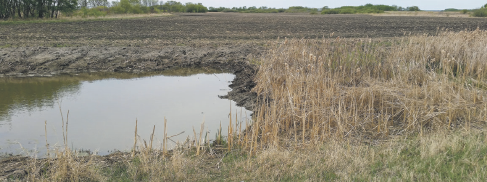Good fences make good neighbours, as the saying goes. But in the R.M. of Wallace-Woodworth, water troubles don’t stop at fencelines.
Such was the case when upstream neighbours decided to drain a little water off their land during the last week of May, by blowing a beaver dam.
Ever since the flood of 2011 in southwestern Manitoba, underground aquifers became full and drainage has become an issue.
Four presentations were made to the Wallace-Woodworth Council meeting of May 26. All of them were issues related to surface water and drainage.
Agricultural producers in Wallace-Woodworth have found, to their dismay, sloughs are impinging upon arable land and pastures. Water-loving beavers, however, are taking advantage of
an increased habitat - water surrounded by aspen, poplar and willow trees. At the sound of running water, they build a dam. They are even damming ditches.
Farmland Beaver Damage Control Program, was an item on the council meeting agenda. Assistant CAO Carole-Anne Brethour stated, “We’ve been approved for that program to a maximum
of $2,828.”
Councillors discussed how to rid the municipality of these large rodents. Reeve Carter asked for more information regarding a legitimate means of control, saying, “If somebody could bring
us up-to-date; we have a tremendous problem.”
He said, “beavers’ dams can be built miles away from our roads, we can’t even see them. When they open up, they can just blow you away.” He was alluding to the
amount of water that can be held back by a beaver dam.
When that dam breaks, the rush of water can ruin roads and flood fields. The Assistant CAO brought forward a question from a ratepayer, regarding a bounty on beaver.
One presentation to Council was from John and Kim Shepherd. The Shepherds described a flooding incident due to a beaver dam, complete with photos.
These farmers in the Kola area, along with neighbours, were the recipients of extra water when Boundary Lane Colony put a ‘small hole’ in what the Shepherds termed as “a huge beaver dam”.
This, as it turned out, was not in Council’s power to deal with. The dam was not on municipal property, such as a right-of-way. However, the Shepherd’s presentation strengthened Council’s concern
to deal with the beaver issue, which will include a policy for beaver control.
In an interview following the meeting, Kim Shepherd admitted that the dam needed to be opened. However, the Shepherds wished it had been done much earlier, even last fall. They were
not consulted beforehand; but water flows downhill, so it covered some of their freshly seeded property and flowed to other landowners. Also noteworthy, they report there is a lot of water still being held back by that beaver structure.
Another delegation was from Ducks Unlimited. The rise in water levels has affected their drainage structures and dams as well. Mark Humphries, from north of Kola, complained
of his roads, affected by rain and surrounding sloughs.
Adam Bajus from the Kola area came to council asking about drainage. “Have you dealt with any of the drainage projects that were opened in the western part of the municipality?”
Reeve Carter said “No.”
Bajus asked, “So as people that are being affected by this, how do we get it started again?” Bajus explained there were two or three places where culverts were supposed to be installed last
fall. This has resulted in water over roads.
He was told that under provincial regulations drainage cannot happen until June 15.




